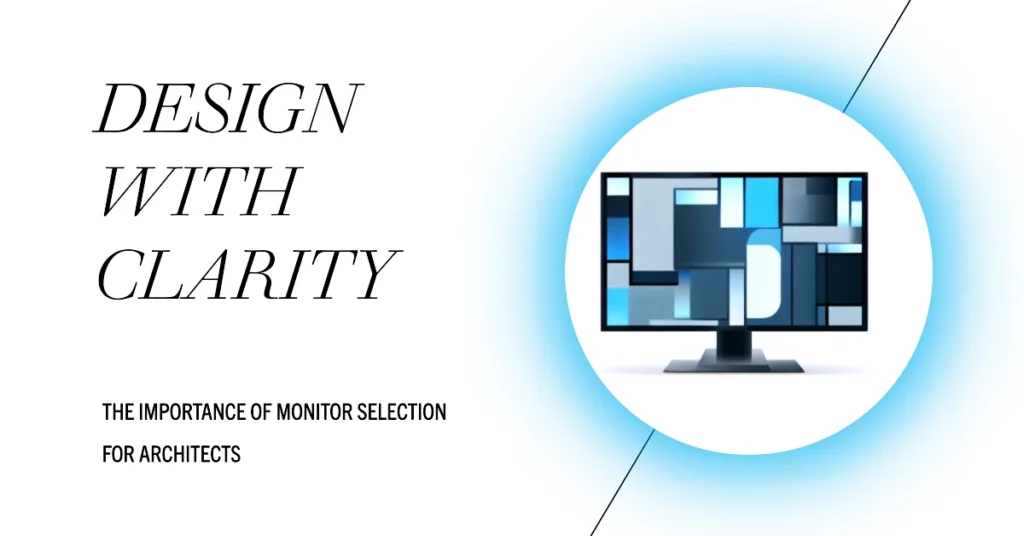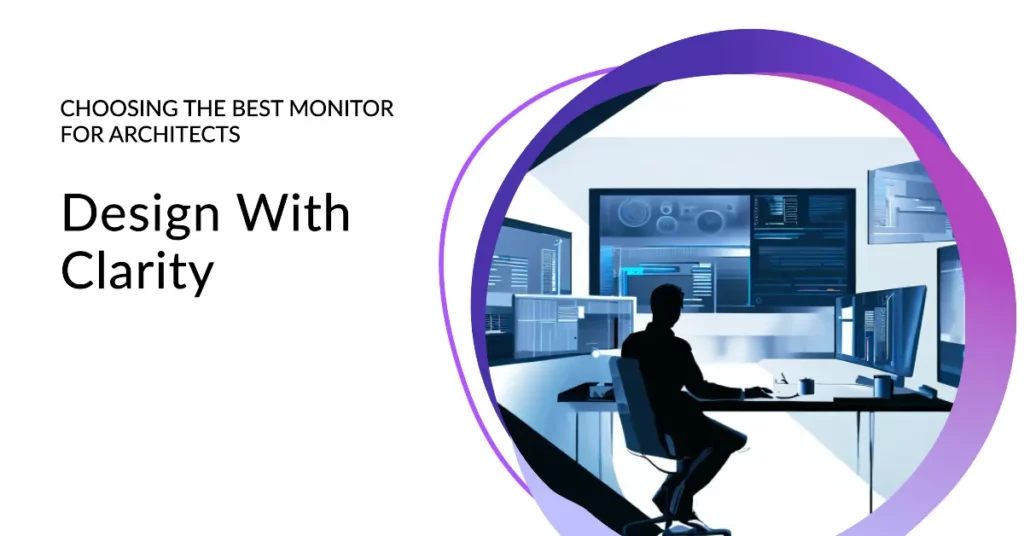If you’re an architect, you know your monitor can be your best asset or your worst enemy. Many architects struggle with subpar monitors that don’t display colors accurately, can’t handle high-res renderings, or lack the ergonomic design to be used comfortably for long periods.
Working with a monitor that isn’t up to the task can be frustrating and can seriously impair your productivity and the quality of your work.
Imagine working long hours on a crucial project, only to realize that your designs appear differently on your client’s screen, leading to misunderstandings and setbacks.
Or consider the stress and eye strain caused by staring at a flickering or blurred display all day. Issues like these can accumulate, affecting not just your work quality but also your well-being.
That’s why choosing the best monitor for architects is so essential. In this article, we’ll delve into the key features you should consider, from screen size and resolution to color accuracy and connectivity options.
We’ve also compiled a list of top picks, catering to a range of budgets and needs, so you can make an informed decision and finally get a monitor that complements your architectural work.
Stay tuned as we guide you through the maze of options to find the best monitor that suits your professional demands, ensuring you never have to compromise on quality or efficiency again.
Why Monitor Selection is Crucial for Architects
In architectural design, the monitor selection process assumes a paramount role beyond mere aesthetics.
Architects, as meticulous creators of intricate spatial narratives, find themselves intricately tied to the quality and precision of their visual tools. Delving into the heart of the matter, it becomes evident why monitor selection is crucial for architects.
As purveyors of innovation, architects rely on monitors to transpose their abstract visions into tangible blueprints. A crucial aspect of this translation lies in the accuracy of color representation.
Monitors with high color gamut and calibration capabilities empower architects to envisage their designs in true-to-life hues, ensuring their creative essence is unadulterated by technological limitations.
In the dynamic world of architectural collaboration, monitors function as the conduits through which design concepts are communicated. A meticulously chosen monitor can bridge the gap between an architect’s mind and the client’s perception.
High-resolution monitors with wide viewing angles ensure that intricate details remain intact even during presentations, fostering a deeper appreciation of the architect’s craftsmanship.
The selection process warrants thoughtful consideration of various factors, including resolution, size, and ergonomics. Architects engage in tasks that demand pixel-perfect precision, necessitating monitors with ample pixel density to portray fine lines and textures. A larger monitor canvas, on the other hand, enables architects to work seamlessly across multiple applications, enhancing productivity.
It is imperative to acknowledge the evolving landscape of architectural workflows, which technological advancements have significantly shaped.
From Building Information Modeling (BIM) to real-time rendering, modern architects are immersed in a digital renaissance that mandates monitors with high refresh rates and adaptive sync technologies. These attributes curtail motion blur and screen tearing, thus preserving the fluidity of architectural animations.
In summation, the symbiotic relationship between architects and monitors transcends the ordinary. The precision, vibrancy, and clarity that monitors confer act as enablers, propelling architects toward the zenith of their creative prowess.
Monitor selection stands as a crucial cornerstone for architects as they sculpt the skylines of tomorrow with their visionary designs.
Key Criteria for Choosing the Best Monitor
In the dynamic realm of architectural design, selecting the best monitor for architects is a nuanced process that hinges upon several key criteria. These criteria influence the precision and quality of work and impact the overall creative experience.
Delving into the intricacies, we uncover the essential factors architects must consider before selecting their monitors.
Resolution: A cornerstone criterion, resolution plays a pivotal role in architects’ workflows. Opting for a monitor with a high resolution, such as 4K or even ultra-wide QHD, grants architects the canvas to portray intricate details with pixel-perfect clarity. This is particularly vital when working on detailed blueprints and 3D models.
Color Accuracy: Architects rely on a monitor’s ability to reproduce colors faithfully. Monitors equipped with a wide color gamut and calibration capabilities ensure that every shade is represented accurately, translating the creative vision from mind to screen without distortion.
Size and Aspect Ratio: The size of the monitor, complemented by an appropriate aspect ratio, profoundly influences productivity and visual comfort. A larger monitor grants ample screen real estate for multitasking, while an ultra-wide aspect ratio enhances the experience of working with panoramic designs.
Ergonomics: Architects spend extended hours at their workstations, making ergonomics a crucial criterion. Monitors with adjustable stands, swivel, tilt, and height options enable architects to customize their setup for optimal comfort, reducing the risk of strain during long sessions.
Connectivity: Seamlessly integrating into the architect’s workflow, monitors equipped with diverse connectivity options like USB-C, HDMI, and DisplayPort ensure compatibility with various devices and facilitate efficient data transfer.
Refresh Rate and Response Time: While often overlooked, the refresh rate and response time are vital for architects engaging in real-time 3D rendering and animations. A higher refresh rate minimizes motion blur, while a quick response time ensures smoother transitions.
In conclusion, architects benefit immensely from a meticulous evaluation of these key criteria when embarking on the journey of choosing the best monitor. A well-selected monitor becomes more than a tool—it becomes a conduit for architectural brilliance, empowering architects to translate their creative visions with unparalleled precision and finesse.
Top Picks for the Best Monitors for Architects
1. LG 34WL500-B – Best Budget Option
In the ever-evolving architectural design landscape, the quest for the best monitor for architects leads us to the exceptional LG 34WL500-B. This masterpiece of technology encapsulates a harmonious fusion of innovation and functionality, catering to the discerning needs of architects with a keen eye for precision.
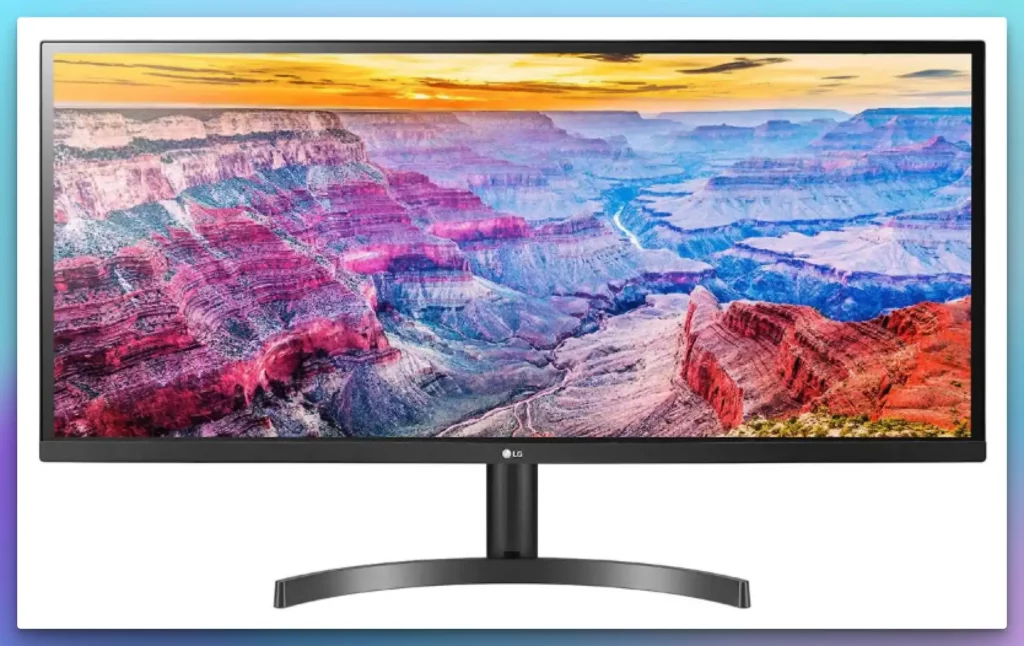
Visual Brilliance: The LG 34WL500-B emerges as a beacon of visual brilliance, boasting a generous 34″ 21:9 UltraWide screen that paints an expansive canvas for architectural marvels. This widescreen expanse harmonizes with the architect’s creative process, affording ample space to delve into intricate design details and panoramic vistas.
UltraWide Immersion: The 21:9 aspect ratio is not just a specification—it’s an immersive journey architects embark upon as they delve into their creations. This ultra-wide expanse transforms architectural blueprints into captivating narratives, allowing architects to experience their designs in a new dimension where creativity knows no bounds.
Full HD Flourish: The Full HD prowess of the LG 34WL500-B breathes life into architectural renderings. With its IPS LED technology, this monitor renders colors with unparalleled accuracy, enabling architects to witness their visions come to life with true-to-life hues and shades, a testament to its commitment to precision.
HDR10 Elevation: Elevating the experience further, including HDR10 compatibility, injects a dynamic range of contrast and brightness, breathing life into architectural visualizations. The interplay of light and shadow, a hallmark of architectural aesthetics, is faithfully depicted, allowing architects to evaluate their designs under realistic lighting conditions.
Aesthetics and Ergonomics: The LG 34WL500-B marries aesthetics with functionality, presenting a sleek, minimalist design that seamlessly integrates into any architectural workspace. The monitor’s adjustable stand ensures ergonomic comfort, which is critical for architects who invest countless hours crafting their masterpieces.
In the symphony of architectural creativity, the LG 34WL500-B is a harmonious conductor, orchestrating a symphony of innovation and precision. With its immersive UltraWide canvas, color accuracy, HDR brilliance, and ergonomic design, this monitor invites architects to embrace a new dimension of design exploration.
The LG 34WL500-B isn’t just a monitor; it’s a portal to architectural excellence, where every pixel resonates with the architect’s passion and vision.
Pros:-
UltraWide Immersion: The 21:9 UltraWide aspect ratio gives architects an expansive canvas, offering ample space to work on intricate details and panoramic vistas.
Full HD Resolution: The Full HD resolution combined with IPS LED technology ensures accurate color representation, enabling architects to view their designs with true-to-life hues and shades.
HDR10 Compatibility: Including HDR10 support enhances contrast and brightness, allowing architects to evaluate their designs under realistic lighting conditions and showcase intricate interplays of light and shadow.
Sleek Design: The monitor’s sleek and minimalist design seamlessly fits into modern architectural workspaces, adding an aesthetic touch to the environment.
Ergonomic Adjustability: The adjustable stand promotes ergonomic comfort, enabling architects to customize the monitor’s position for extended periods of productive work.
Multitasking Capability: The widescreen provides ample space for multitasking, allowing architects to work on multiple applications or documents simultaneously.
Cons:-
Limited Color Gamut: While the monitor offers accurate color representation, its color gamut might be limited compared to higher-end monitors, potentially affecting the ability to view a wider range of colors.
Resolution Limitation: While Full HD is sufficient for many tasks, some architects may desire higher resolutions for ultra-detailed work, which the monitor might not offer.
Refresh Rate: The monitor’s refresh rate might not be as high as some premium gaming monitors, which could impact the smoothness of animations or transitions.
HDR Performance: While HDR10 compatibility is a positive feature, the monitor’s peak brightness and local dimming performance might not match that of dedicated HDR displays.
Connectivity Options: The monitor’s connectivity options might be limited compared to other models, potentially affecting compatibility with various devices.
Size Preference: The 34″ size might not suit all architects’ preferences, as some might prefer larger or smaller screens based on their workspace and design needs.
In the grand scheme of architectural creativity, the LG 34WL500-B presents a compelling package with its immersive design, color accuracy, and ergonomic features. However, it’s important for architects to weigh the pros and cons against their specific requirements and preferences before making their monitor choice.
2. Samsung Odyssey G9
In the ever-evolving realm of architectural design, the Samsung Odyssey G9 emerges as the quintessential choice, earning its title as the best monitor for architects.
This technological marvel transcends traditional boundaries, offering architects an unparalleled platform to transform their creative visions into tangible masterpieces.
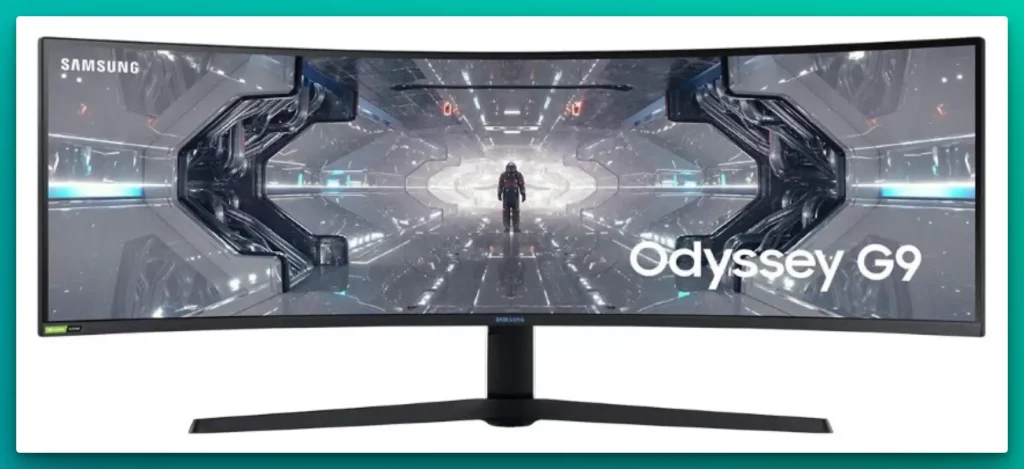
5K QHD Brilliance: The Samsung Odyssey G9 elevates visual clarity with its remarkable 5K QHD resolution, breathing life into every intricate architectural detail. Architects immerse themselves in a symphony of colors and textures, where even the minutest elements of their designs come to life with unprecedented precision.
Ultra-Wide Panorama: With its expansive 49-inch screen, the Odyssey G9 provides architects with a canvas of epic proportions. This ultra-wide panorama invites architects to embrace expansive vistas, enabling them to encapsulate their designs within a breathtaking expanse that mirrors the limitless horizons of their imagination.
Immersive Curvature: The monitor’s dual-curved design creates an immersive experience, enveloping architects in a cocoon of visual engagement. This curvature mimics the natural curvature of human vision, rendering architectural blueprints in a manner that resonates deeply with the creator.
HDR Splendor: Architectural aesthetics flourish under the brilliance of High Dynamic Range (HDR) technology. The Odyssey G9 introduces architects to a world where light and shadow harmonize, unveiling designs under a spectrum of luminosity that mirrors reality.
The fluidity of Motion: Architects navigate the world of animated design seamlessly, thanks to the 240Hz refresh rate and 1ms response time of the Odyssey G9. This fluidity of motion caters to real-time 3D rendering and architectural animations, ensuring smooth and captivating transitions.
Ergonomic Elegance: The monitor’s ergonomic stand empowers architects to tailor their workspace for ultimate comfort during extended design sessions. The ability to adjust height, tilt, and swivel adds precision to the architect’s workflow.
In the symphony of architectural creation, the Samsung Odyssey G9 rises as the conductor of brilliance, harmonizing 5K QHD resolution, immersive curvature, and HDR prowess. This monitor isn’t merely a tool; it’s a gateway to architectural excellence.
The Samsung Odyssey G9 invites architects to breathe life into their dreams, offering a level of detail and immersion that truly defines what it means to be the best monitor for architects.
Pros:-
5K QHD Resolution: The 5K QHD resolution delivers unparalleled clarity, allowing architects to work on intricate design details with precision.
Ultra-Wide Panorama: The 49-inch ultra-wide screen provides an expansive canvas for architects to visualize and manipulate their designs.
Immersive Curvature: The dual-curved design enhances immersion, aligning with natural vision curvature for an engaging viewing experience.
HDR Enhancement: High Dynamic Range (HDR) technology enriches architectural visualizations by reproducing a wider range of colors and contrast, capturing intricate lighting nuances.
Fluid Motion Handling: A 240Hz refresh rate and 1ms response time ensure smooth transitions and animations, crucial for architects engaged in real-time 3D rendering.
Ergonomic Design: The ergonomic stand offers adjustable height, tilt, and swivel options, promoting comfort during extended design sessions.
Cons:-
Price Point: The advanced features of the Odyssey G9 come at a premium cost, making it a significant investment for architects on a budget.
Large Size: The 49-inch size might not suit all workspaces or personal preferences, especially in smaller settings.
Gaming-Centric Features: While advantageous for animations, the monitor’s gaming-focused attributes might not align perfectly with all architectural needs.
Color Accuracy: While HDR technology enhances color reproduction, color accuracy might still vary compared to dedicated professional-grade monitors.
Limited Connectivity: The monitor’s connectivity options might be limited compared to monitors designed for professional workflows.
Learning Curve: The monitor’s advanced features might require some time for architects to familiarize themselves with its full potential and customization options.
In the grand panorama of architectural creativity, the Samsung Odyssey G9 presents a compelling package with its 5K QHD resolution, immersive design, and fluid motion handling.
While its advantages are evident for architects seeking precision and immersive experiences, weighing the cons against specific requirements and budget considerations before investing in this state-of-the-art monitor is essential.
3. ASUS ROG Swift PG42UQ
In the dynamic realm of architectural design, where precision meets innovation, the ASUS ROG Swift PG42UQ emerges as a beacon of excellence, rightfully earning its title as the best monitor for architects. This technological masterpiece goes beyond conventional boundaries, offering architects an unrivaled canvas to manifest their creative visions.
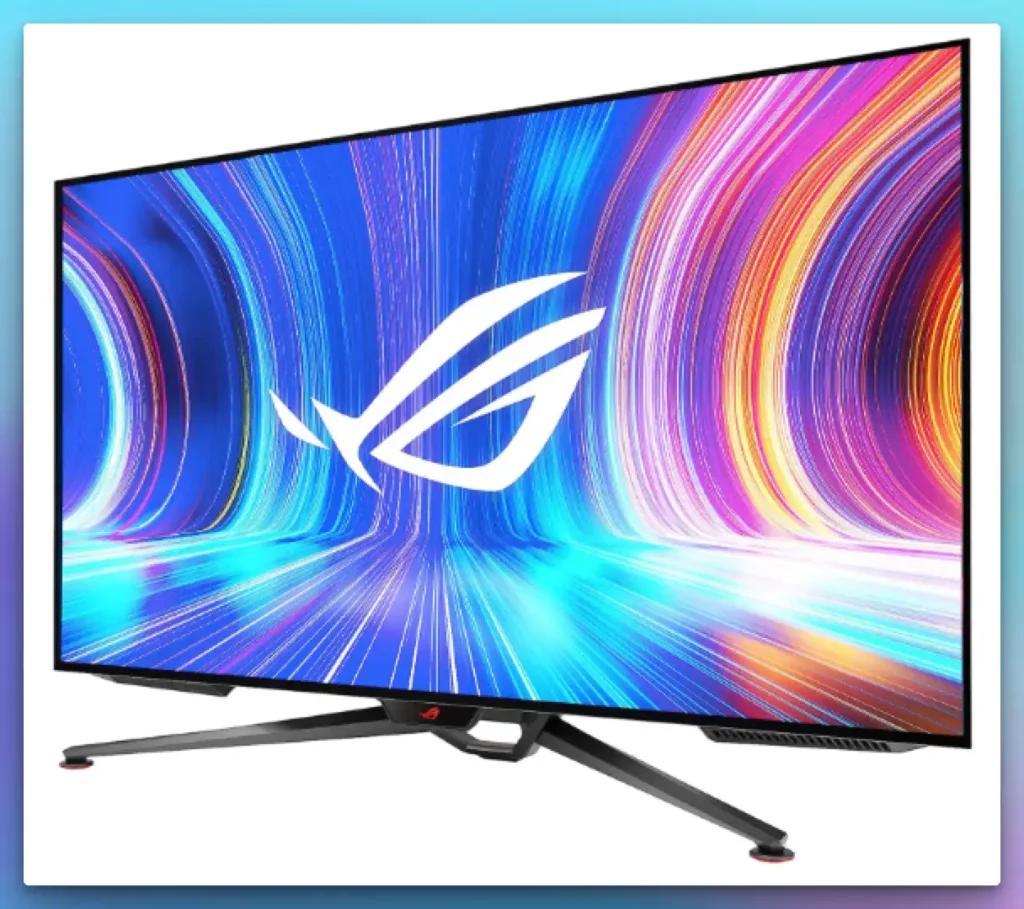
4K UHD Brilliance: The ASUS ROG Swift PG42UQ unleashes unparalleled visual brilliance with its pristine 4K UHD (3840 x 2160) resolution. Architects immerse themselves in a symphony of ultra-high-definition details, where every nuance of their designs is brought to life with breathtaking clarity.
138Hz Refresh Harmony: The monitor’s remarkable 138Hz refresh rate bestows architects with a fluid canvas for their creativity to unfold. This elevated refresh rate ensures that architects experience smooth transitions and animations, which are crucial for assessing architectural dynamism.
0.1ms Response Grace: Architects traverse the realm of rapid design iterations seamlessly, thanks to the monitor’s 0.1ms response time. This rapid response ensures that every pixel change is mirrored instantly, eliminating the veil of latency and enhancing precision.
True 10-bit Palette: The ASUS ROG Swift PG42UQ embraces a true 10-bit color palette, painting architectural visualizations with a rich spectrum of colors and shades that match the artist’s intent. Architects are empowered to visualize their designs with unparalleled color accuracy.
DCI-P3 98% Spectrum: The monitor’s coverage of DCI-P3 98% color spectrum mirrors real-world colors, enabling architects to experience their designs as they would under natural lighting conditions.
G-SYNC Harmony: The G-SYNC compatibility ensures that architects explore their designs with reduced tearing and smoother visuals, ensuring that nothing disrupts the creative flow.
Console Readiness: The monitor’s console readiness extends its versatility, allowing architects to explore diverse design mediums beyond traditional computing.
In the symphony of architectural innovation, the ASUS ROG Swift PG42UQ emerges as the orchestrator of brilliance, harmonizing 4K UHD resolution, rapid refresh rates, and impeccable color accuracy.
This monitor isn’t merely a device; it’s a conduit to architectural excellence, inviting architects to infuse their visions with unprecedented detail and life. The ASUS ROG Swift PG42UQ transcends being a monitor; it’s a gateway to architectural transcendence, where every pixel echoes the architect’s passion and visionary aspirations.
Pros:-
4K UHD Resolution: The 4K UHD (3840 x 2160) resolution offers architects an immersive visual experience with exceptional clarity for detailed design work.
High Refresh Rate: The 138Hz refresh rate ensures smooth animations and transitions, contributing to a seamless design exploration process.
Ultra-Fast Response Time: With a response time of 0.1ms, architects can engage in rapid design iterations without latency, enhancing precision and workflow.
True 10-bit Color: The true 10-bit color palette provides architects with accurate and vibrant color representation for their designs.
Wide Color Spectrum: The DCI-P3 98% color coverage ensures that architects view their designs with colors closely mirroring real-world conditions.
G-SYNC Compatibility: G-SYNC compatibility minimizes tearing and enhances visual smoothness, creating a more immersive experience during design exploration.
Console Readiness: The monitor’s readiness for console use expands its versatility beyond traditional computing, accommodating diverse design mediums.
Cons:-
Price Point: The advanced features of the ASUS ROG Swift PG42UQ can result in a higher price, which might be a consideration for architects on a budget.
Large Size: The 41.5-inch size might not suit all workspaces or architectural preferences, particularly in more compact settings.
Gaming-Centric Features: While beneficial for animations, some of the monitor’s features might be geared towards gaming rather than architectural work.
Connectivity Options: The range of connectivity options might be more tailored to gaming setups and might lack certain ports or features preferred by professionals.
Learning Curve: Architects new to gaming monitors might take time adjusting to features like high refresh rates and adaptive sync technologies.
Overkill for Some Needs: The monitor’s advanced capabilities might be overkill for architects who primarily work with 2D designs and don’t require gaming-oriented specifications.
In the grand spectrum of architectural creativity, the ASUS ROG Swift PG42UQ offers a powerful package with 4K UHD resolution, rapid refresh rates, and color accuracy. While its advantages are evident, architects must consider their specific requirements, budget constraints, and familiarity with gaming-oriented features when choosing this monitor for their creative pursuits.
4. SAMSUNG Odyssey G7
In the ever-evolving realm of architectural design, where precision and economy coalesce, the SAMSUNG Odyssey G7 emerges as a beacon of distinction, earning its title as the best budget monitor for architects.
This technological marvel transcends cost constraints, offering architects a window into precision without compromising resources.
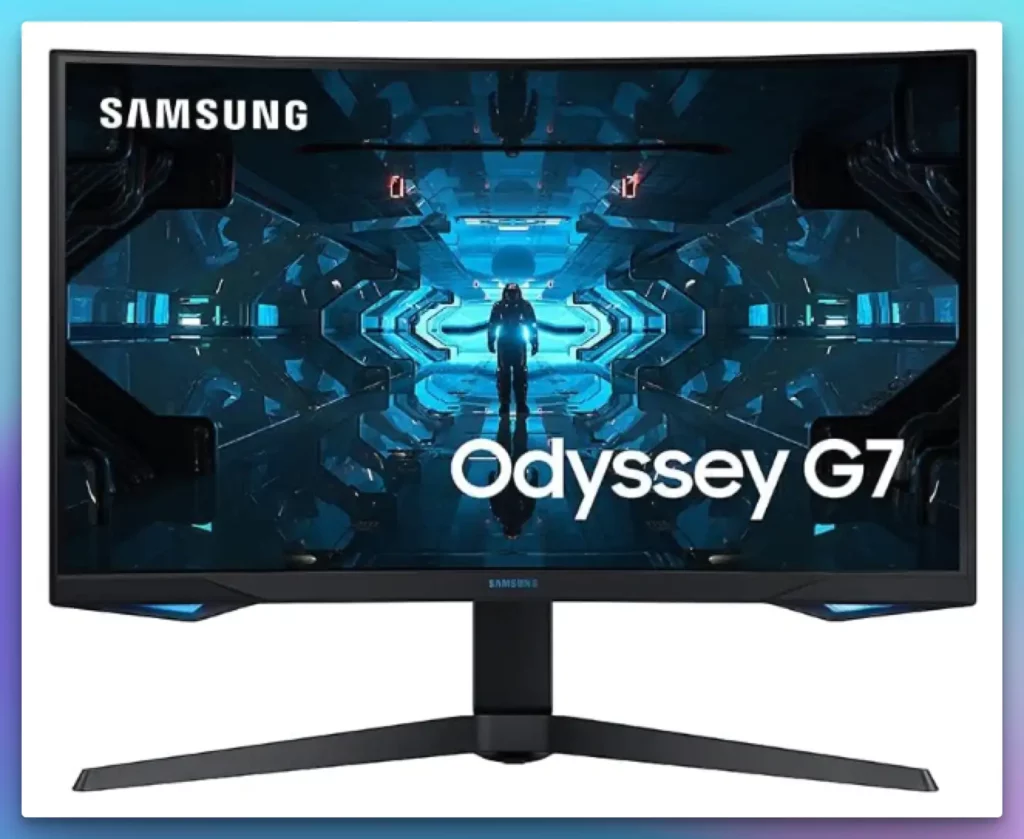
WQHD Brilliance: The SAMSUNG Odyssey G7 introduces an elevated level of visual excellence with its WQHD (2560×1440) resolution. Architects are immersed in intricate details, and each pixel carries the weight of their creative aspirations.
240Hz Fluidity: The monitor’s impressive 240Hz refresh rate ensures fluid transitions and animations, allowing architects to explore their designs with a smoothness that complements their creative flow.
Curved Enchantment: The curved design of the Odyssey G7 wraps architects in an immersive experience, seamlessly aligning with their field of vision. This curvature creates an engagement zone where architectural blueprints come to life with added depth and realism.
1ms Response Brilliance: Architects navigate the journey of precision with agility, thanks to the monitor’s 1ms response time. This rapid response minimizes motion blur, ensuring that every detail is portrayed.
G-Sync and FreeSync Fusion: The monitor’s G-Sync and FreeSync Premium Pro compatibility combines adaptive sync technologies, reducing screen tearing and delivering seamless visuals.
Budget-Conscious Excellence: The SAMSUNG Odyssey G7 offers a gateway to architectural brilliance without stretching the budget. It aligns with the needs of architects who demand precision without compromising financial prudence.
In the grand tapestry of architectural creation, the SAMSUNG Odyssey G7 embodies budget-friendly prowess, harmonizing WQHD resolution, rapid refresh rates, and a curved design. This monitor isn’t just a tool; it’s an avenue to architectural precision within budgetary constraints.
The SAMSUNG Odyssey G7 invites architects to transcend limitations, where every pixel resonates with their passion and craftsmanship without breaking the bank.
Pros:-
WQHD Resolution: The WQHD (2560×1440) resolution provides architects with a crisp and clear visual experience, ideal for detailed design work.
High Refresh Rate: The 240Hz refresh rate ensures smooth animations and transitions, contributing to a seamless design exploration process.
Curved Design: The curved design of the monitor enhances immersion, aligning with the natural field of vision and adding depth to architectural blueprints.
Rapid Response Time: With a 1ms response time, architects can engage in swift design iterations without motion blur, ensuring accurate representation.
Adaptive Sync Compatibility: The fusion of G-Sync and FreeSync Premium Pro technologies minimizes screen tearing and provides a smooth visual experience.
Budget-Friendly: The SAMSUNG Odyssey G7 offers high-quality features within a budget-friendly price range, making it accessible to architects looking for precision without overspending.
Cons:-
Resolution Consideration: While WQHD is an improvement over Full HD, some architects might prefer higher resolutions for more detailed work, which the monitor might not offer.
Gaming-Centric Features: Some features, such as high refresh rates and adaptive sync technologies, might be more geared towards gaming than architectural tasks.
Color Accuracy: While the monitor provides good visual quality, its color accuracy might not match that of professional-grade monitors, which could be a consideration for architects working on color-sensitive projects.
Limited Size Options: The 32-inch size might not suit all workspaces or personal preferences, especially in smaller settings.
Connectivity Limitations: The monitor’s connectivity options might be more tailored toward gaming setups and might lack certain ports or features preferred by professionals.
Learning Curve: Architects new to gaming monitors might need time to adjust to features like high refresh rates and adaptive sync technologies.
In architectural creativity, the SAMSUNG Odyssey G7 offers a compelling package with its WQHD resolution, rapid refresh rates, and curved design—all within a budget-friendly framework.
While its advantages are evident, architects should consider their specific requirements and preferences and how well the monitor’s features align with their architectural tasks before making their decision.
5. BenQ PD3200U
In the intricate world of architectural design, precision is paramount. The BenQ PD3200U emerges as a force to reckon with, crowned as the best monitor for architecture rendering. This technological marvel seamlessly harmonizes innovation and functionality, offering architects an unparalleled canvas to manifest their creative visions.
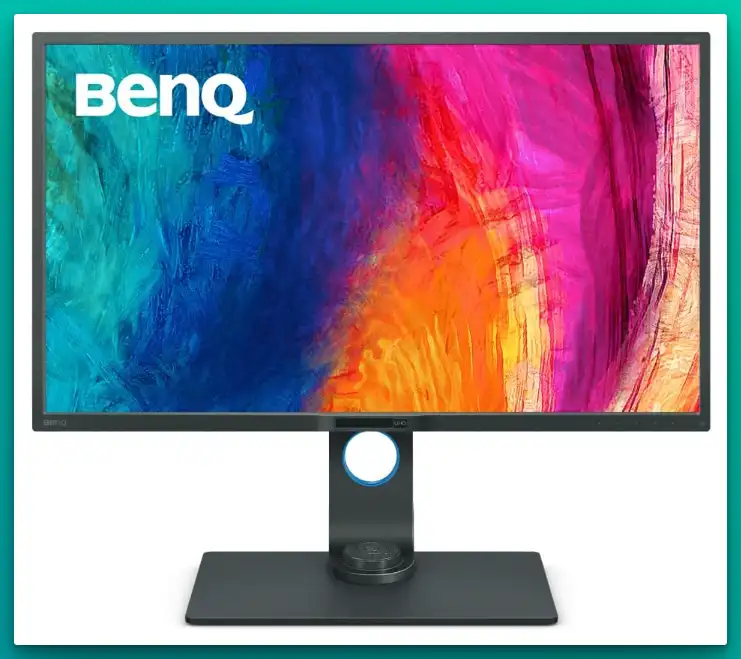
4K UHD Brilliance: The BenQ PD3200U introduces a realm of visual excellence with its crystal-clear 4K UHD resolution. Architects embark on a journey of intricate design details, where each pixel is imbued with significance and meaning.
Color Perfection: With support for 100% Rec.709 and sRGB color spaces, the monitor delivers the color accuracy architects crave. The IPS technology ensures consistent color reproduction from wide viewing angles.
Delta E≤3 Accuracy: The monitor boasts a remarkable Delta E≤3 accuracy, a testament to its commitment to precise color representation. Architects can rely on this monitor to deliver the true essence of their creations.
Calibration Report: The included calibration report is a testament to the monitor’s dedication to accuracy. Architects can trust that their designs will be faithfully rendered, free from color discrepancies.
AQCOLOR and Pantone Validation: The AQCOLOR technology, validated by Pantone, offers architects a color experience that resonates with authenticity. Every hue and shade is a true reflection of the intended design.
HotKey Puck Convenience: The inclusion of the HotKey Puck streamlines the creative process, enabling architects to switch between color modes and inputs with a single touch.
Ergonomic Design and Speakers: The monitor’s ergonomic design ensures comfort during long design sessions, while the integrated speakers cater to aesthetic and functional needs.
In architectural precision, the BenQ PD3200U reigns supreme, aligning 4K UHD resolution, color accuracy, and validation by industry standards. This monitor isn’t just a tool; it’s a gateway to architectural excellence.
The BenQ PD3200U beckons architects to embark on a journey of precision, where every pixel resonates with their passion and design prowess, creating a symphony of creativity that leaves an indelible mark on architecture.
Pros:-
4K UHD Resolution: The 4K UHD resolution delivers exceptional clarity, allowing architects to work on intricate design details with utmost precision.
Color Accuracy: Support for 100% Rec.709 and sRGB color spaces ensures accurate color representation, which is vital for architects to visualize their designs authentically.
Delta E≤3 Accuracy: The monitor’s remarkable Delta E≤3 accuracy guarantees minimal color discrepancies, reflecting the essence of architectural creations.
Calibration Report: The included calibration report showcases the monitor’s commitment to precision, assuring architects of consistent and faithful color rendering.
AQCOLOR and Pantone Validation: The AQCOLOR technology validated by Pantone ensures that architects experience a true-to-life color palette, allowing their designs to come to life authentically.
HotKey Puck Convenience: The HotKey Puck simplifies the design process, offering architects quick access to color modes and inputs, and enhancing workflow efficiency.
Ergonomic Design: The monitor’s ergonomic design promotes comfort during extended design sessions, reducing strain and fatigue.
Integrated Speakers: The presence of integrated speakers adds a layer of convenience for architects who require audio feedback during design exploration.
Cons:-
Price Point: The advanced color accuracy and features of the BenQ PD3200U might result in a higher price than standard monitors.
Size Preference: The 32-inch size might not suit all architects’ preferences, especially those who prefer larger or smaller screens based on their workspace.
Limited Refresh Rate: The monitor’s refresh rate might be lower than gaming-oriented monitors, affecting the smoothness of animations or transitions.
Gaming-Centric Features: While the monitor offers color accuracy, it might not have features tailored specifically for gaming, which could be less relevant for architects.
Connectivity Options: The range of connectivity options might not be as extensive as monitors designed for gaming or professional workstations.
Learning Curve: Architects new to color-accurate monitors might need time to understand and utilize the full range of color management features.
In architectural rendering, the BenQ PD3200U offers a compelling package with its 4K UHD resolution, color accuracy, and validation by industry standards. Architects should consider these factors and their specific requirements before choosing this monitor to enhance their precision.
6. KOORUI 34 Inch Ultrawide Curved Monitor
Precision marries innovation in the dynamic realm of architectural design, and the KOORUI 34-inch Ultrawide Curved Monitor emerges as the epitome of excellence.
Crowned the best-curved monitor for architecture, it encapsulates the seamless fusion of form and function, offering architects an unparalleled canvas to bring their creative visions to life.
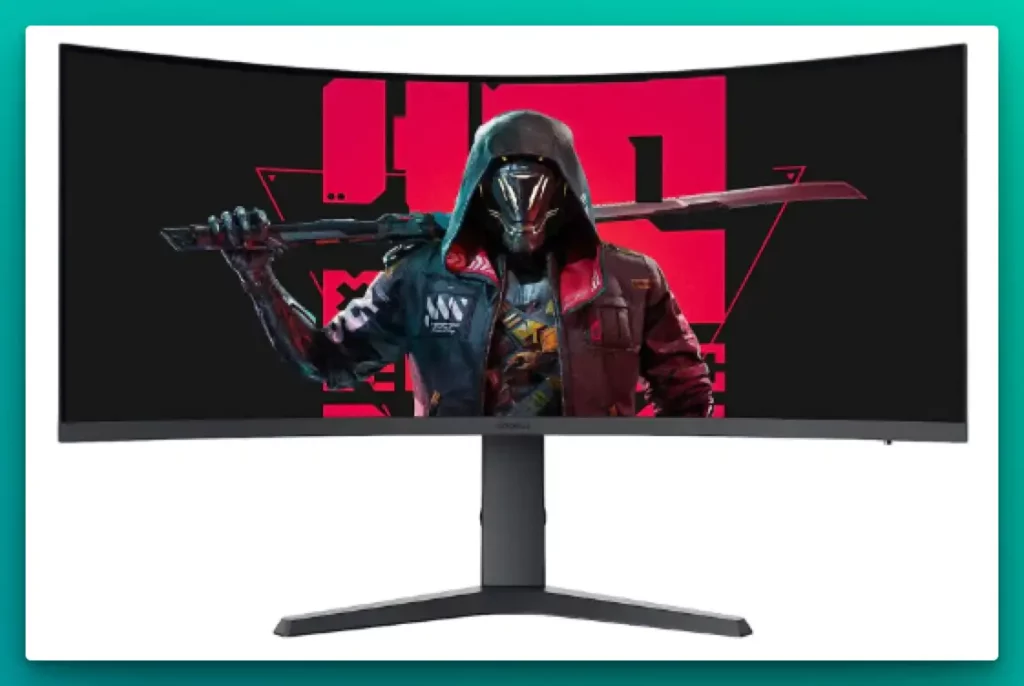
165Hz Visual Symphony: The KOORUI 34-inch Ultrawide Curved Monitor introduces architects to a visual symphony, boasting a remarkable 165Hz refresh rate. With each frame transitioning smoothly, architects immerse themselves in a fluid realm where design exploration knows no bounds.
Curvature, Perfected: The monitor’s 1000R curvature envelopes architects in a world of visual immersion. This curvature aligns with the natural curve of the human eye, ensuring that every architectural detail is experienced in a manner that resonates deeply.
WQHD Wonder: With a captivating WQHD 3440 x 1440 resolution, architects venture into a realm of visual brilliance. Each pixel radiates precision, enhancing the intricacies of architectural blueprints.
DCI-P3 90% Color Gamut: The monitor’s embrace of DCI-P3 90% color gamut creates a vivid color spectrum, mirroring architectural designs with vibrant and true-to-life hues.
Adaptive Sync Harmony: Compatibility with Adaptive Sync technology harmonizes frame rates, minimizing screen tearing and ensuring that architects experience a seamless visual journey.
Ergonomic Elegance: The monitor’s tilt and height adjustable stand caters to architects’ ergonomic needs, promoting comfort during extended design sessions.
In architectural creativity, the KOORUI 34-inch Ultrawide Curved Monitor reigns as the embodiment of curved precision, intertwining high refresh rates, curvature perfection, and a vivid color gamut. This monitor isn’t just a device; it’s an invitation to architectural brilliance.
The KOORUI 34-inch Ultrawide Curved Monitor beckons architects to embark on a journey where every curve, pixel, and hue shapes the symphony of their design narrative, leaving an indelible mark on the canvas of architectural innovation.
Pros:-
High Refresh Rate: The impressive 165Hz refresh rate delivers smooth animations and transitions, enhancing the fluidity of architectural exploration.
Curvature Immersion: The 1000R curvature envelops architects in an immersive visual experience, aligning with the natural curve of the eye for enhanced engagement.
WQHD Resolution: The captivating WQHD 3440 x 1440 resolution showcases intricate architectural details with remarkable clarity.
Vibrant Color Gamut: The monitor accurately reproduces vibrant colors with a DCI-P3 90% color gamut, ensuring that architectural designs are represented authentically.
Adaptive Sync Compatibility: The monitor’s compatibility with Adaptive Sync technology ensures smooth visuals, minimizing screen tearing for an uninterrupted design process.
Ergonomic Design: The tilt and height adjustable stand promotes ergonomic comfort during prolonged design sessions, reducing strain and fatigue.
Cons:-
Price Consideration: The monitor’s advanced features, such as high refresh rates and curved design, might result in a higher price than standard monitors.
Size Preference: The 34-inch ultrawide size might not suit all architects’ preferences, especially those who prefer larger or smaller screens for their workspace.
Gaming-Focused Features: Some features, like high refresh rates and adaptive sync, might align more with gaming needs rather than architectural tasks.
Color Accuracy: While the monitor offers vibrant colors, its accuracy might not match that of professional-grade monitors designed specifically for color-sensitive work.
Connectivity Options: The range of connectivity options might not be as extensive as monitors designed for professional workstations.
Learning Curve: Architects new to curved monitors might take some time to adapt to the curvature and fully utilize its benefits.
In the tapestry of architectural exploration, the KOORUI 34-inch Ultrawide Curved Monitor weaves together high refresh rates, curvature immersion, and a vibrant color gamut. Architects should consider these factors and their specific requirements to determine if this monitor aligns with their design preferences and workflow needs.
7. ViewSonic VX3276-4K-MHD
In interior design, where creativity converges with precision, the ViewSonic VX3276-4K-MHD emerges as a canvas of innovation. Crowned the best monitor for interior designers, it weaves together form and function, offering designers an unmatched platform to transform creative visions into tangible masterpieces.
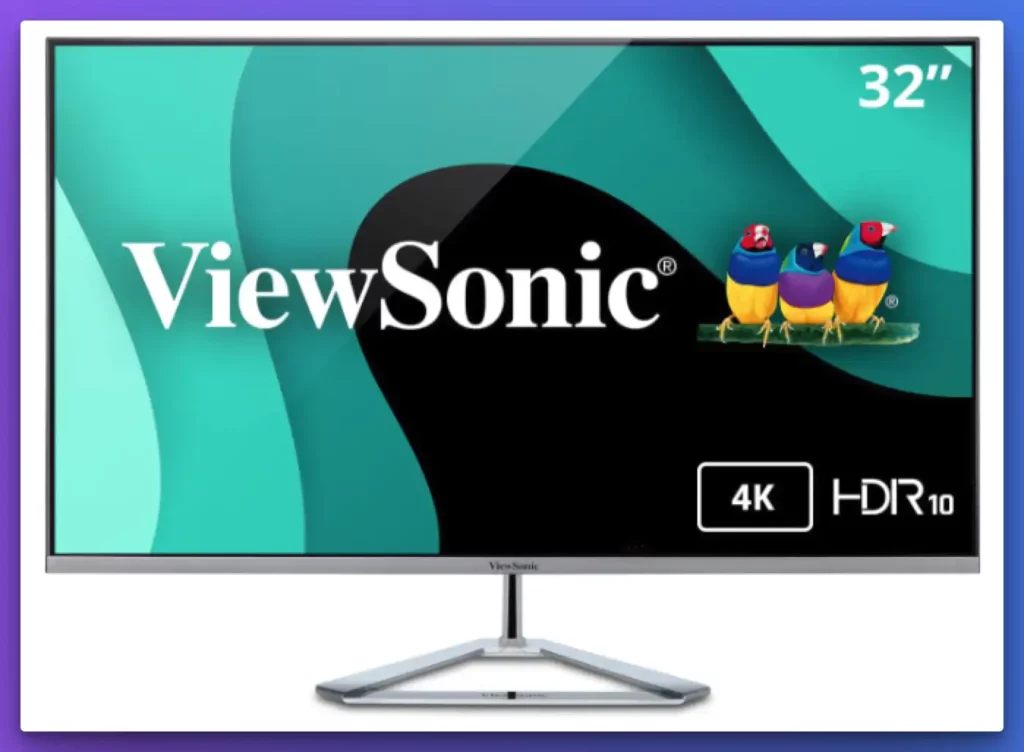
4K UHD Elegance: The ViewSonic VX3276-4K-MHD brings forth a symphony of visual elegance with its 4K UHD resolution. Interior designers immerse themselves in a realm where every design detail comes alive with unparalleled clarity.
Ultra-Thin Bezels: With its ultra-thin bezels, the monitor offers a borderless visual experience, maximizing the screen real estate and allowing designers to focus solely on their creative canvas.
HDR10 Brilliance: The monitor’s support for HDR10 technology enhances color and contrast, elevating interior design visuals to vibrancy that mirrors the designer’s intent.
HDMI and DisplayPort Connectivity: Including HDMI and DisplayPort connectivity ensures seamless interaction between the monitor and design devices, facilitating a fluid design workflow.
Versatile Utility: The ViewSonic VX3276-4K-MHD transcends design realms, seamlessly adapting to home and office environments. It’s a testament to its versatile utility.
Precision Craftsmanship: Interior designers demand precision, and the monitor’s display quality is a testament to this. It reproduces colors and details with the accuracy that interior design projects demand.
In the symphony of interior design creativity, the ViewSonic VX3276-4K-MHD emerges as a true virtuoso, harmonizing 4K UHD elegance, HDR10 brilliance, and versatile utility. This monitor isn’t just a tool; it’s a window to design mastery.
The ViewSonic VX3276-4K-MHD invites interior designers to immerse themselves in a world where every pixel, every shade, and every detail echoes their passion, culminating in a masterpiece that defines the art of interior design.
Pros:-
4K UHD Resolution: The 4K UHD resolution offers interior designers exceptional clarity, allowing them to visualize intricate design details with unparalleled precision.
Ultra-Thin Bezels: The monitor’s ultra-thin bezels create a borderless visual experience, maximizing the screen space and providing an immersive canvas for design exploration.
HDR10 Enhancement: Support for HDR10 technology enhances color and contrast, resulting in visuals that capture the vibrancy and depth of the designer’s creative intent.
HDMI and DisplayPort Connectivity: HDMI and DisplayPort connectivity ensures seamless communication between the monitor and design devices, facilitating a smooth design workflow.
Versatile Usage: The monitor effortlessly transitions between home and office environments, showcasing its versatility and adaptability.
Color Accuracy: The display’s color accuracy ensures that interior designers can rely on the monitor to reproduce colors and details accurately, which is crucial for design projects.
Cons:-
Price Consideration: The monitor’s advanced features, such as 4K resolution and HDR10 support, might result in a higher price than standard monitors.
Size Preference: The 32-inch size might not suit all interior designers’ preferences, especially those who prefer larger or smaller screens based on their workspace.
Design-Centric Features: Some features, such as high refresh rates or gaming-specific enhancements, might be less relevant for interior designers focused solely on design tasks.
Limited Color Gamut: While the monitor supports HDR10, its color gamut might not match high-end professional monitors designed specifically for color-critical work.
Learning Curve: Interior designers new to 4K resolution and HDR technology might need time to understand and optimize these features for their design workflow.
In the symphony of interior design creativity, the ViewSonic VX3276-4K-MHD weaves together 4K UHD resolution, HDR10 enhancement, and versatile connectivity. Designers should consider these factors and their requirements to determine if this monitor aligns with their design preferences and workflow needs.
8. Acer CB382CUR
In architectural innovation, the Acer CB382CUR emerges as a beacon of excellence, crowned the best monitor for architects. This technological masterpiece bridges the gap between form and function, offering architects an unrivaled platform to transform their creative visions into tangible marvels.
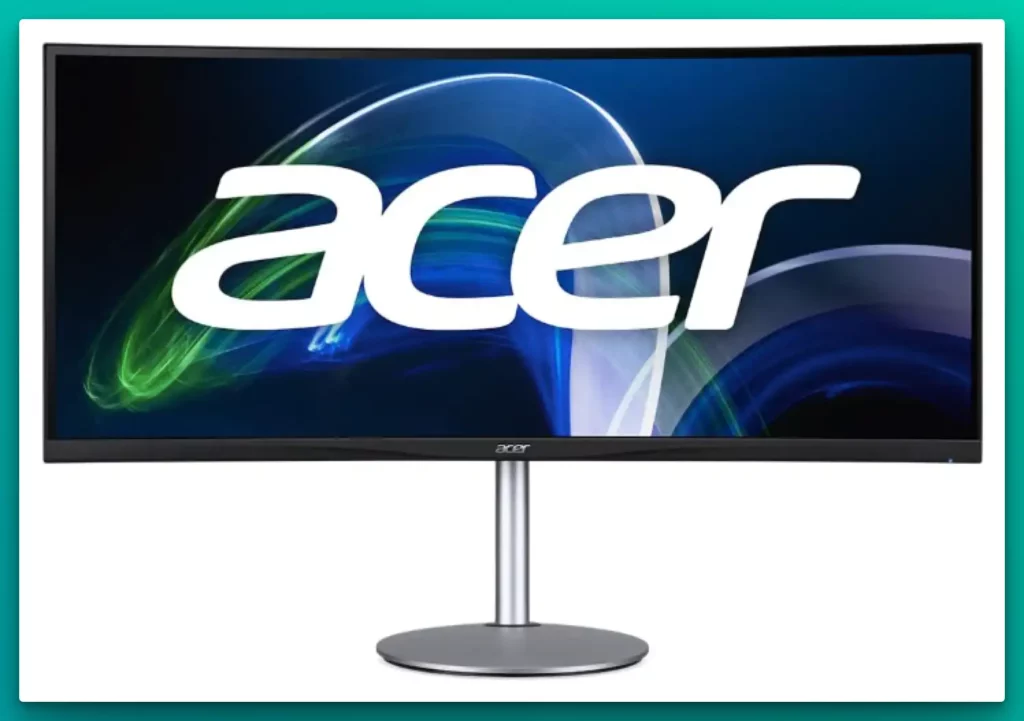
Immersive Curvature: The Acer CB382CUR introduces architects to an immersive experience with its 2300R curved design. This curvature aligns seamlessly with the eye’s natural viewing angle, enveloping architects in a canvas of design brilliance.
QHD+ Visual Splendor: With a captivating QHD+ (3840 x 1600) resolution, architects venture into a world of visual splendor. Every pixel is imbued with precision, enhancing the intricacies of architectural blueprints.
Zero-Frame Elegance: The monitor’s zero-frame design eliminates visual distractions, allowing architects to focus solely on their creative canvas without hindrance.
DCI-P3 95% Color Gamut: The monitor’s support for DCI-P3 95% color gamut ensures that architectural designs are brought to life with vibrant and true-to-life hues.
Fluid Performance: With an up to 75Hz refresh rate and a swift 1ms VRB response time, architects experience fluid transitions and animations, enhancing their design exploration journey.
Versatile Connectivity: The presence of USB 3.1 (Type-C), HDMI 2.0, and DisplayPort connectivity options enhances the monitor’s versatility, enabling architects to interact with various devices seamlessly.
In the symphony of architectural creativity, the Acer CB382CUR embodies precision, merging curved elegance, QHD+ brilliance, and versatile connectivity. This monitor isn’t just a tool; it’s a portal to architectural magnificence.
The Acer CB382CUR beckons architects to embark on a journey where every pixel, every curve, and every hue reflects their passion, culminating in architectural wonders that redefine the landscape of design innovation.
Pros:-
Immersive Curvature: The 2300R curved design immerses architects in an expansive visual canvas, aligning seamlessly with the natural viewing angle for enhanced engagement.
QHD+ Resolution: The QHD+ (3840 x 1600) resolution offers architects exceptional clarity, allowing them to visualize intricate design details precisely.
Zero-Frame Design: The monitor’s zero-frame design maximizes screen real estate, providing architects with an unobstructed view of their creative canvas.
Vibrant Color Gamut: With support for DCI-P3 95% color gamut, the monitor accurately reproduces colors, ensuring that architectural designs are vibrant and true.
Fluid Performance: The up to 75Hz refresh rate and 1ms VRB response time ensure smooth transitions and animations, enhancing the fluidity of design exploration.
Versatile Connectivity: USB 3.1 (Type-C), HDMI 2.0, and DisplayPort connectivity options enable architects to connect and interact with various devices seamlessly.
Cons:-
Price Consideration: The monitor’s advanced features, including curved design and high resolution, might result in a higher price than standard monitors.
Size Preference: The 37.5-inch size might not suit all architects’ preferences, especially those who prefer smaller or larger screens based on their workspace.
Gaming-Centric Features: Some features, such as high refresh rates, might be more tailored towards gaming needs rather than architectural tasks.
Limited Refresh Rate: The refresh rate might be lower than monitors designed specifically for gaming, which could affect the smoothness of animations or transitions.
Learning Curve: Architects new to curved monitors might need time to adjust to the curvature and optimize their viewing experience.
Color Calibration: While the monitor offers a vibrant color gamut, professionals requiring precise color calibration might need additional tools to achieve the desired accuracy.
In architectural creativity, the Acer CB382CUR seamlessly blends curved elegance, QHD+ brilliance, and versatile connectivity. Architects should consider these factors and their specific requirements to determine if this monitor aligns with their design preferences and workflow needs.
9. ViewSonic VP3481a
In architectural innovation, where precision is paramount, the ViewSonic VP3481a emerges as a beacon of excellence and is crowned the best monitor for architects. This technological masterpiece seamlessly blends form and function, offering architects an unparalleled platform to transform their creative visions into tangible marvels.
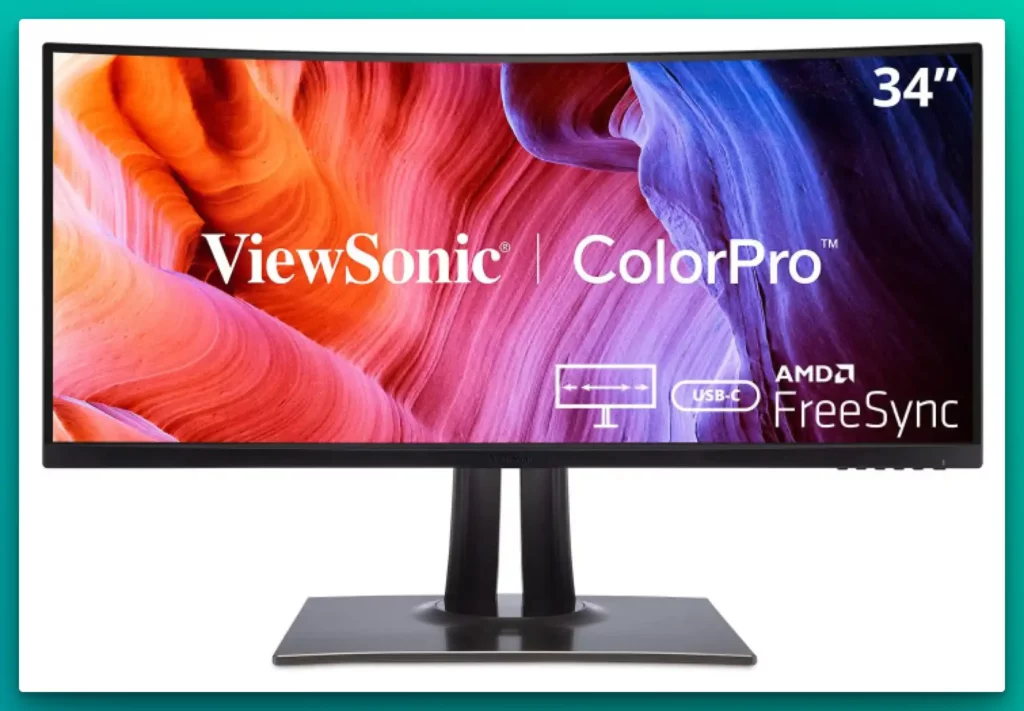
WQHD+ Brilliance: The ViewSonic VP3481a introduces architects to a world of visual brilliance with its WQHD+ resolution. Every pixel resonates with clarity, enhancing the intricacies of architectural blueprints.
Curved Elegance: The monitor’s gently curved design envelops architects in an immersive experience. This curvature aligns seamlessly with the natural curve of the eye, fostering engagement and immersion.
ColorPro 100% sRGB Rec 709: The monitor’s support for ColorPro 100% sRGB Rec 709 ensures that architectural designs are brought to life with true-to-life colors, allowing architects to visualize their concepts authentically.
14-bit 3D LUT: The 14-bit 3D Look-Up Table (LUT) enhances color accuracy, offering architects the precision required for color-sensitive projects.
FreeSync Dynamics: The inclusion of FreeSync technology minimizes screen tearing and stuttering, ensuring a seamless visual experience during design exploration.
Eye Care and 90W USB-C: The monitor’s Eye Care technology reduces eye strain during prolonged work sessions, while the 90W USB-C connectivity streamlines device charging and data transfer.
In the symphony of architectural creativity, the ViewSonic VP3481a is a testament to precision, weaving together WQHD+ brilliance, curved elegance, and advanced color technology.
This monitor isn’t just a tool; it’s a portal to architectural mastery. The ViewSonic VP3481a invites architects to embark on a journey where every pixel, every curve, and every hue embodies their passion, culminating in architectural marvels that redefine the landscape of design innovation.
Pros:-
WQHD+ Resolution: The WQHD+ resolution offers architects exceptional clarity, allowing them to visualize intricate design details precisely.
Curved Elegance: The monitor’s gently curved design enhances immersion, aligning seamlessly with the eye’s natural viewing angle for a more engaging experience.
ColorPro 100% sRGB Rec 709: Support for ColorPro 100% sRGB Rec 709 ensures accurate color representation, allowing architects to see their designs in true-to-life hues.
14-bit 3D LUT: The 14-bit 3D Look-Up Table (LUT) enhances color accuracy, a crucial feature for architects working on color-sensitive projects.
FreeSync Technology: The inclusion of FreeSync technology minimizes screen tearing and stuttering, providing a smooth visual experience during design work.
Eye Care Technology: The monitor’s Eye Care technology reduces eye strain during long design sessions, promoting comfort and well-being.
90W USB-C Connectivity: The 90W USB-C connectivity streamlines device charging and data transfer, enhancing productivity and convenience.
Cons:-
Price Consideration: The monitor’s advanced features, including curved design and color accuracy, might result in a higher price than standard monitors.
Size Preference: The 34-inch size might not suit all architects’ preferences, especially those who prefer smaller or larger screens based on their workspace.
Gaming-Centric Features: Some features like FreeSync technology might be more tailored towards gaming needs rather than architectural tasks.
Limited Refresh Rate: The monitor’s refresh rate might be lower than monitors designed specifically for gaming, which could impact the smoothness of animations.
Learning Curve: Architects new to curved monitors might need time to adapt to the curvature and optimize their viewing experience.
Connectivity Options: While the monitor offers USB-C connectivity, the ports might not be as extensive as those designed for professional workstations.
In architectural design, the ViewSonic VP3481a harmonizes WQHD+ resolution, curved elegance, and advanced color technology. Architects should weigh these factors and their specific requirements to determine if this monitor aligns with their design preferences and workflow needs.
10. SAMSUNG UJ59
In architectural innovation, where precision meets creativity, the SAMSUNG UJ59 is a testament to excellence, earning its title as the best monitor for architects. This technological masterpiece seamlessly blends form and function, offering architects an unparalleled platform to transform their visions into tangible design marvels.
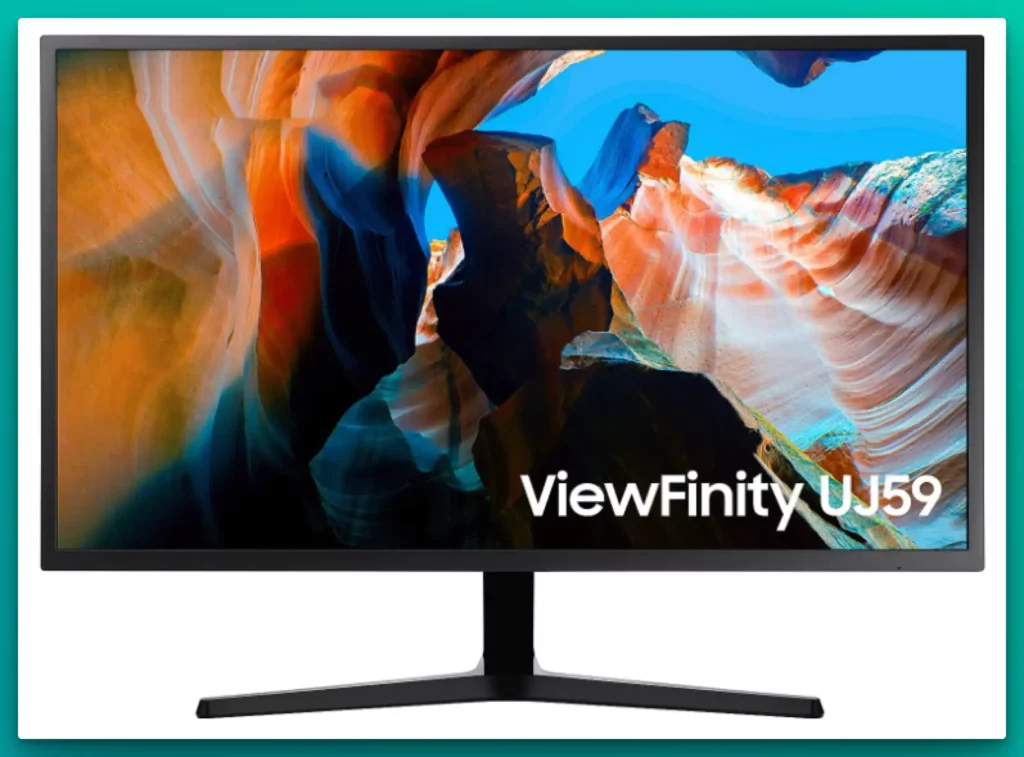
4K UHD Brilliance: The SAMSUNG UJ59 introduces architects to a world of visual brilliance with its 4K UHD (3840×2160) resolution. Each pixel resonates with clarity, enhancing the intricacies of architectural blueprints.
Optimal Connectivity: With HDMI and Display Port connectivity options, architects enjoy a seamless interaction between their devices and the monitor, streamlining their workflow.
Eye Saver and Flicker-Free Mode: Including Eye Saver and Flicker-Free Mode technologies ensures architects can work comfortably for extended periods, reducing eye strain and fatigue.
FreeSync Dynamics: The monitor’s compatibility with FreeSync technology ensures a smooth visual experience, minimizing screen tearing and stuttering during design exploration.
Enhanced Color Reproduction: The SAMSUNG UJ59 accurately reproduces colors, allowing architects to visualize their designs precisely and authentically.
In the symphony of architectural creativity, the SAMSUNG UJ59 is a beacon of precision, weaving together 4K UHD brilliance, optimal connectivity, and eye care technologies. This monitor isn’t just a tool; it’s a gateway to architectural mastery.
The SAMSUNG UJ59 invites architects to embark on a journey where every pixel, every detail, and every hue reflects their passion, culminating in architectural wonders that redefine the boundaries of design innovation.
Pros:-
4K UHD Resolution: The 4K UHD (3840×2160) resolution offers architects exceptional clarity, enabling them to visualize intricate design details with unparalleled precision.
Optimal Connectivity: HDMI and Display Port connectivity options allow architects to connect their devices, facilitating a smooth and efficient workflow.
Eye Saver and Flicker-Free Mode: The monitor’s inclusion of Eye Saver and Flicker-Free Mode technologies reduces eye strain and fatigue, ensuring architects can work comfortably for extended periods.
FreeSync Technology: Compatibility with FreeSync technology ensures a smooth visual experience by minimizing screen tearing and stuttering during design work.
Enhanced Color Reproduction: The SAMSUNG UJ59 accurately reproduces colors, allowing architects to visualize their designs authentically and precisely.
Cons:-
Limited Refresh Rate: The monitor’s refresh rate might not be as high as some monitors designed specifically for gaming or fast-paced tasks, which could impact the smoothness of animations.
Size Preference: The 32-inch size might not suit all architects’ preferences, especially those who prefer larger or smaller screens based on their workspace.
Color Accuracy: While the monitor offers enhanced color reproduction, it might not match the color accuracy of high-end professional-grade monitors designed for color-critical work.
Professional Features: Some advanced features tailored for professional design work, such as advanced color calibration options, might be missing compared to specialized monitors.
Gaming-Centric Features: The presence of FreeSync technology might be more aligned with gaming needs rather than architectural tasks.
The SAMSUNG UJ59 weaves 4K UHD brilliance, optimal connectivity, and eye care technologies in architectural creativity. Architects should consider these factors and their specific requirements to determine if this monitor aligns with their design preferences and workflow needs.
Best monitor size for architects
When elevating the architectural design process, selecting the best monitor size for architects is an essential consideration that can significantly impact workflow efficiency and design precision.
Architects engage in intricate tasks that demand a delicate equilibrium between clarity and screen real estate. A spacious monitor lets architects view their projects comprehensively, enabling them to work seamlessly with large-scale drawings, detailed plans, and intricate 3D models.
While larger screens offer enhanced visibility, it’s vital to avoid excessive sizes that could strain neck muscles during extended periods of work. Architects often find a monitor size of 27 to 32 inches the sweet spot. This range provides an expansive canvas for designs without overwhelming the field of vision.
Moreover, the choice of monitor size should align with the display’s resolution. Opting for a 4K monitor in the preferred size range enhances the clarity of intricate design elements and facilitates precise detailing in architectural plans.
Ultimately, the best monitor size for architects marries immersive visuals with ergonomic comfort. Architects should experiment with different sizes within the recommended range to discover the dimensions that seamlessly complement their creative process while ensuring ergonomic well-being.
📗FAQ’s
What type of monitor is best for architecture?
When delving into architectural tasks, monitor choice is pivotal. Opt for a high-resolution display, ideally 4K, for impeccable clarity and precision in design visualization.
What monitor is best for CAD?
CAD enthusiasts require a monitor with impeccable color accuracy and a spacious screen. Look for a monitor with an IPS panel and ample screen real estate to accommodate intricate designs.
Which monitor is best for Revit?
A monitor with excellent color representation and wide viewing angles is indispensable for Revit projects, ensuring seamless collaboration and accurate project assessment.
Do you prefer curved or flat monitor?
The choice between curved and flat monitors hinges on personal preference. Curved monitors offer an immersive experience, while flat monitors maintain consistent geometry representation.
Are curved monitors OK for CAD?
Curved monitors can be used for CAD, though flat monitors are traditionally favored due to their ability to maintain geometric accuracy without any distortion.
How much RAM should I have for CAD?
A minimum of 16GB RAM is recommended for CAD work, while more complex projects may benefit from 32GB or even 64GB for smoother multitasking and rendering.
Is more RAM better for CAD?
Increasing RAM beyond a certain point offers diminishing returns for CAD tasks. Optimal performance can be achieved with 32GB RAM for most architectural endeavors.
How much RAM should an architect have?
Architects can work effectively with 32GB of RAM, balancing performance and practicality for running various design applications.
What do architects use most?
Architects extensively employ BIM software like Revit, AutoCAD, and SketchUp, alongside rendering tools such as Lumion or V-Ray for visualizing designs.
What scale do most architects use?
The most common architectural scale is 1/4 inch to 1 foot, facilitating detailed representation while allowing for manageable physical model sizes.
Is 4K monitor worth it for CAD?
A 4K monitor elevates CAD productivity by offering superior visual clarity, enabling architects to work with intricate details more comfortably.
Is more RAM better for Revit?
Revit performance scales well with increased RAM capacity. 32GB or more can notably enhance responsiveness and project handling.
Which RTX is best for Revit?
The NVIDIA RTX 3080 or 3090 are superb for Revit, with their potent processing power and ample VRAM for handling complex architectural models.
What are the disadvantages of a curved monitor?
Curved monitors might exhibit slight color distortion at the edges and present challenges when collaborating or designing precise geometric elements.
What are the pros and cons of curved monitors vs flat monitors?
Curved monitors offer immersive viewing, while flat monitors maintain geometric accuracy. The choice hinges on personal preference and the type of work being done.
Are curved monitors better for your eyes?
Curved monitors can reduce eye strain by matching the natural curve of the eye. However, this advantage is subjective and might not apply universally.
Why do some people not like curved monitors?
Some individuals find curved monitors less suitable for tasks requiring accurate geometric representation, such as CAD work.
Why do pros not use curved monitors?
Professionals often prioritize geometric accuracy, making flat monitors preferred for design, architecture, and engineering tasks.
Why do people prefer curved monitors?
Curved monitors are favored for immersive visual experience, enhancing gaming, multimedia consumption, and certain design tasks.
Do curved monitors warp the image?
Modern curved monitors minimize image distortion and maintain visual fidelity across the screen when designed and manufactured correctly.
Is 32GB RAM too much for AutoCAD?
While 32GB RAM might be considered overkill for basic AutoCAD use, it greatly benefits larger projects and smoother multitasking.
Is 32 gigs of RAM overkill?
For resource-intensive tasks like CAD and 3D modeling, 32GB RAM balances performance and cost-effectiveness.
Is 16 or 32 GB RAM better for CAD?
32GB RAM is more suitable for CAD, accommodating larger projects and enabling efficient multitasking without slowdowns.
Is 64 GB of RAM overkill for CAD?
For most architects, 64GB RAM is excessive and offers little performance improvement over 32GB. It’s advisable for specialized scenarios.
Do I need 32GB RAM for CAD?
32GB RAM is recommended for architects engaged in CAD work to ensure smooth operation and enhanced project handling.
What is the best RAM for CAD design?
Opt for high-speed DDR4 RAM, preferably in a dual-channel configuration, to ensure swift data access and seamless multitasking.
How much SSD do I need for architecture?
A 500GB to 1TB SSD provides ample storage for architectural projects, applications, and data, ensuring swift data access.
Do architects need powerful computers?
Architects benefit from powerful computers with multi-core processors, ample RAM, and dedicated GPUs for seamless design, modeling, and rendering.
Do I need 32GB RAM for Revit?
32GB RAM significantly improves Revit performance, enabling smoother navigation, quicker rendering, and efficient multitasking during architectural projects.
Conclusion on the best monitor for architects list
As we’ve discussed, architects can’t afford to skimp on their monitors. An unsuitable display can negatively impact the quality of your work, create unnecessary misunderstandings with clients, and even affect your health over the long term due to eye strain and poor ergonomics.
There’s nothing more frustrating than pouring hours into a design only to find out it looks different on other screens or discovering that fine details in your renderings are lost due to a low-resolution monitor. Who wants to end the workday with a headache or sore eyes from staring at a substandard screen?
The good news is that you don’t have to settle for less. Investing in the best monitor for architects can make a world of difference in your work quality and overall well-being. By prioritizing key features like screen size, resolution, color accuracy, and ergonomics, you can elevate your architectural projects and professional presentations.
We’ve walked you through budget-friendly, mid-range, and premium options to suit various needs and financial situations. Whether you’re a student just starting in the field or a seasoned professional, there’s a monitor out there that meets your specific requirements.
Don’t wait until you’re grappling with another project mishap or a looming deadline to make the change. Upgrade to a monitor that’s up to the task today, and experience the positive impact it can have on your architectural career.

























